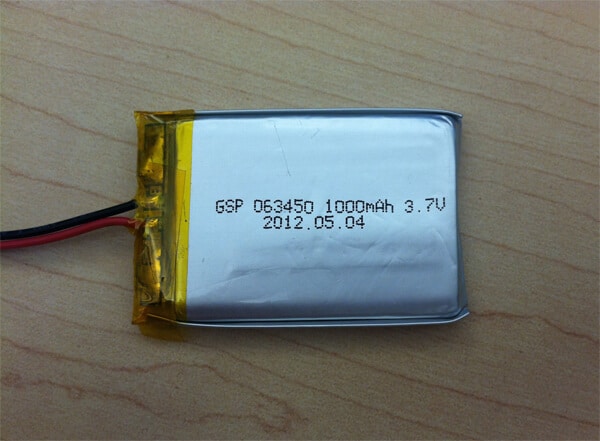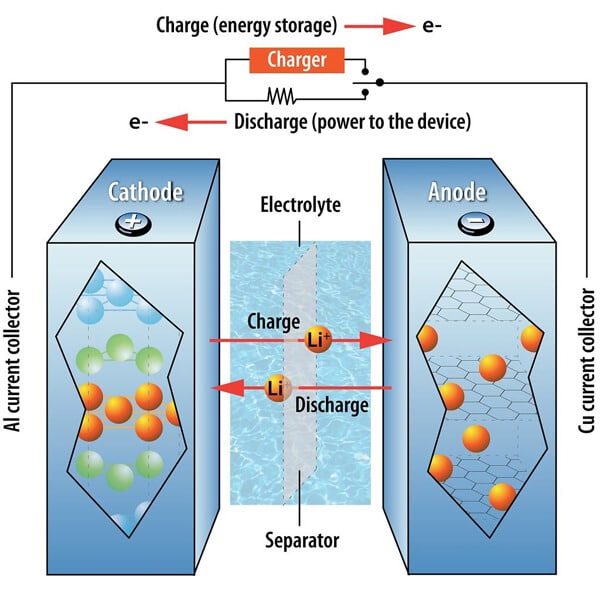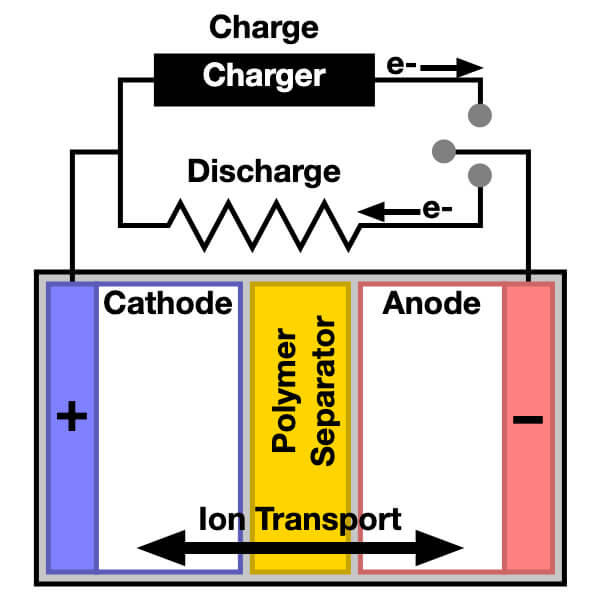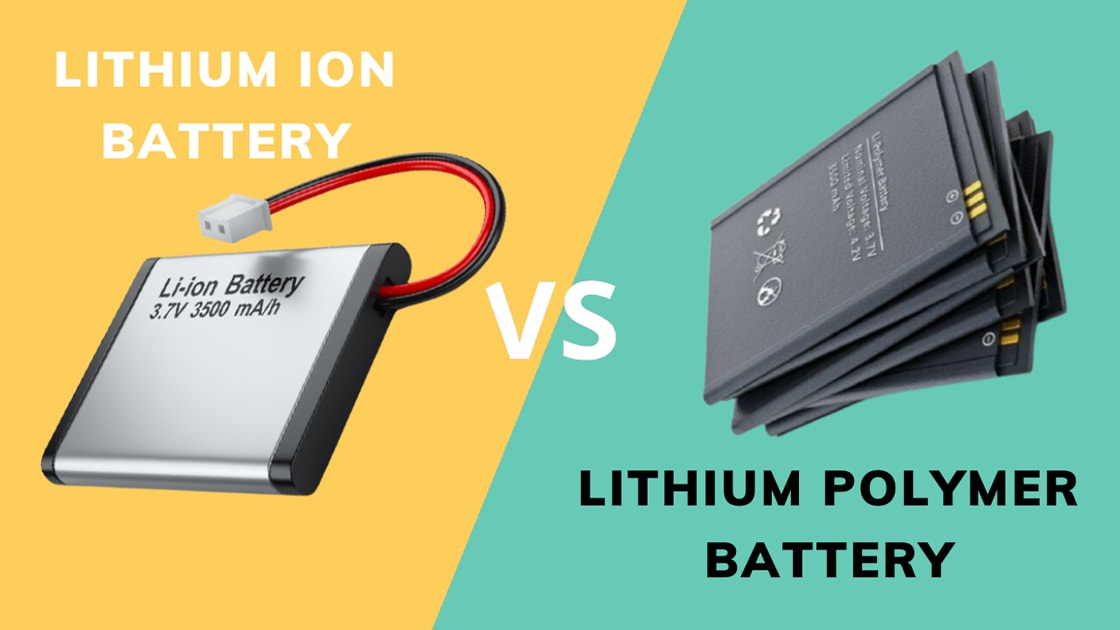Introduction
It seems to be hard to decide on lithium-ion batteries or lithium polymer counterparts. Each type of power bank boasts its pros and cons, making many feel confused when choosing.
To make everything much easier for you, we will share a complete comparison between lithium-ion and lithium polymer batteries.
What Makes Lithium Ion Batteries?
Lithium-ion (Li-ion) batteries are rechargeable power banks. When discharging, lithium ions travel from the negative electrode via an electrolyte to the positive electrode. They move back when charging.

A Lithium Ion Battery
Some typical Li-ion batteries come with high energy density, low self-discharge, and no memory effect. These batteries are also affordable and widely utilized for electric vehicles and portable electronics.
But it is worth noting that this type of battery can sport a safety risk as they have flammable electrolytes, likely leading to fires and explosions if incorrectly charged or damaged.
What Makes Lithium Polymer Batteries?
Lithium polymer (LiPo) batteries use polymer electrolytes rather than liquid electrolytes. Polymer electrolytes are formed from high-conductivity semisolid polymers.

A Lithium Polymer Battery
They offer higher specific energy than their counterparts. Manufacturers often use this type of battery in mobile devices, electric vehicles, and radio-controlled aircraft.
Related:
- What Is Car Battery Voltage? – For A Healthy Vehicle
- A Detailed Guide On How To Test Batteries With A Multimeter
- How Long Do Car Batteries Last? When Should You Replace Them?
- How To Read Car Battery Date Codes? A Simple And Detail Instruction
What’s The Difference Between Lithium Ion And Lithium Polymer Batteries?
Chemical Electrolytes
The biggest difference between lithium-ion and lithium polymer batteries is their chemical electrolytes between negative and positive electrodes. While the Li-ion batteries feature liquid electrolytes, the LiPo counterparts come with polymer ones.

How Lithium Ion Batteries Work
LiPo models utilize one of three types: gel-like electrolytes, porous chemical compounds, and dry solids. The most common type is the gel-like electrolytes widely found in the LiPo batteries of the latest electric cars and laptops.

How Lithium Polymer Batteries Work
Price
Besides, the manufacturing cost of Li-ion batteries is significantly lower than that of LiPo cells, making them more affordable. While they are inexpensive and relatively safe, you should always be cautious when purchasing this type of cell from unknown brands.
Aging
The memory effect happens when the cell suffers losses in the usable capacity from charging and discharging over time. As the LiPo cells experience a memory effect, they come with shorter durability than the Li-ion batteries.
Size & Weight
On the other hand, LiPo batteries are much lighter and more compact than Li-ion cells due to their higher energy density. That is why manufacturers prefer to use LiPo cells in their electronic devices to lower the weight of their products.
Still, it is worth noting that these devices will be more expensive as the manufacturing cost of LiPo batteries is higher than that of Li-ion cells.
Safety
When it comes to safety when used, Li-ion is more likely to explode or catch fire when overcharged. If you do not overcharge or expose them to challenging settings, you do not need to worry about the combustion.
The LiPo is safer as there is a microporous separator to deter electrodes from touching directly. Hence, it is unlikely to have fire or explosion when using LiPo batteries.
Energy Density
Both Li-ion and LiPo cells feature high energy density, but the Li-ion batteries come with better density. In particular, the highest energy density Li-ion batteries feature 250-670 Wh/L while the LiPo batteries have 185 to 220 Wh/L on average.
Conversion Rate
Typically, the conversion rate of the LiPo batteries and Li-ion cells is 75-90% and 85-95%, respectively. The conversion rate refers to the internal battery cell’s power output at a nominal voltage.
The higher it is, the better the cell performance. So, in this case, the Li-ion batteries have better performance than the LiPo cells.
Charging Time
In terms of the time for charging, LiPo has a better score. On average, LiPo cells take about 30 to 60 minutes to fully charge, which greatly depends on the charger’s size and the cell’s size.
Meanwhile, Li-ion batteries normally take merely 150 minutes to fully charge, but they can be charged in less than 60 minutes if they come with fast charging technology.
Verdict
Which is better battery lithium ion or lithium polymer? It is hard to decide which battery is better as they both come with great pros and a few cons.
However, generally speaking, LiPo batteries are a greater option for those seeking portability, while Li-ion counterparts are ideal for those seeking durability.
Pros & Cons
Li-Ion Batteries
- High power density
- No memory effect
- Lower cost
- Long lifespan
- Suffer from aging
- Low safety due to explosion risks
Li-Po Batteries
- Robust and flexible
- Low profile
- Higher safety for avoiding leaking electrolytes
- Expensive
- Low capacity
- Shorter lifespan
Comparison Table Of Differences Between Lithium Ion And Lithium Polymer Battery
| Lithium-ion battery | Lithium polymer battery | |
| Aging | Does not have memory effect for lasting longer | Lower durability due to memory effect |
| Energy density | Slightly higher specific energy density | High density |
| Size | Thick and big | Thin and compact |
| Charging duration | Need to be charged for a long time | Come with a shorter charging time |
| Safety | Likely to catch fire and explode when used incorrectly or damaged | Higher level of safety |
| Conversion rate | 85% – 95% | 75% – 90% |
| Weight | Heavy | Lightweight |
| Price | Affordable | Expensive |
Wrapping Up
Generally, there is not much difference between lithium-ion Vs lithium polymer batteries.
The LiPo cells are more available in higher-end electronic devices for their compact design to reduce the weight of their products. Meanwhile, Li-ion batteries are a better choice in terms of affordability due to the lower manufacturing cost.
Thus, it is best to make your final decision based on your preference and demand. We hope you will have a great time with your battery choice.
Should you have any further questions, feel free to let us know. Thank you for reading!
WHAT'S NEW
The best AGM battery chargers will be the ideal option to revive your flat battery without relying on professional help. These handy high-tech chargers are extremely beneficial because they offer...
The Genius Boost GB40 is popular because of its ability to help boost your vehicle when it has battery issues. Many of our customers wonder why the Noco GB40 can work greatly like so. So, we have...

